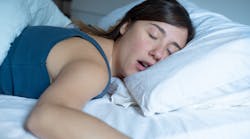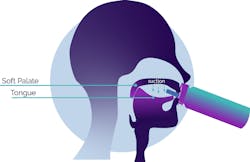Tonsils—check, uvula—check, sore arm from holding the tongue down—check. The throat, also known as the oropharynx or airway, has been neglected in dentistry for too long.
Patients’ eyebrows go up when we ask them, “Do you snore?” after we look in their throat. The Mallampati score is a system that allows anesthesiologists to quickly know how easy it will be to intubate a person. We’re now using the system in dentistry for a quick and easy identifier for patients who may snore.
During their appointments, most patients are prepared for the conversation about dental decay or periodontal disease. They expect us to comment about a lesion or make an obligatory sugar reduction recommendation. Most coast through their appointments defending their brushing, flossing, or diet drink consumption. But when a clinician asks if they snore after looking into their airway, they snap out of their usual stupors.
Dental professionals are becoming more aware of our role in addressing snoring. This usually means some sort of continuous open airway therapy (COAT) device. Holding the mandible forward can open the airway, and in many studies has been shown to be equal to the gold standard, which is CPAP. But not everyone wants or can afford either option. Orofacial myofunctional therapy can help strengthen and harmonize the muscles of the snoring complex.
Alternative solution
As the snoring problem grows, one ingenious company has created a unique snoring solution. Current solutions have focused on mandibular advancement, and precious few have focused on engaging the untoned muscles in the oropharynx. That’s the beauty of the REMplenish water bottle.
Most spouted cups—those with a straw or hose—do not have a lot of engineering incorporated into the design of the spout or nozzle. The silicone of the oval nozzle of the REMplenish water bottle, the brainchild of biomedical engineer and CEO of REMastered Sleep Anders Olmanson, allows the lips to close in more of a straight line as compared to a round spout or straw. The oval nozzle lands on the center of the tongue (figure 1). With the lips and anterior one third of the tongue in place, the posterior of the tongue lowers to create a suction that draws the fluid up the straw, through the small aperture in the nozzle, and into the back of the throat.
Once there, the tongue is then forced to assume the correct posture, tip up to the rugae where it can undulate, and pinch the valve closed to facilitate an accurate transfer of fluid from the oropharynx to the pharynx and down (figure 2). The soft palate is also forced to assume the correct posture for swallowing.
Toning the muscles
There are many reasons why these muscles lack tone. A water bottle nozzle that passively activates these muscles can improve the size of the airway, reduce resistance, and allow for a more peaceful sleep for adults and children alike. Drinking water is key to good health and using a therapeutic nozzle that improves the muscles in the snoring complex can improve health without impacting a person’s schedule.
It may be frustrating at first to get the swallow right. After a few days, the body becomes used to drawing the fluid up the straw using the correct suction and the swallow becomes normalized. While patients are awaiting their dental devices or a sleep study, this type of therapeutic aid can guide them toward better sleep and even better compliance. After a few weeks of drinking one to two bottles of water each day, the toneless muscles in the oropharynx begin to respond.
As the science of snoring, sleep apnea, and orofacial myofunctional therapy mounts, applying simple interventions with low impact on patients’ days can improve their quality of life and potentially even their quantity of life.
Shirley Gutkowski, BSDH, RDH, is a career dental hygienist and owner of Primal Air, OMT and Breathing Retraining. Her practice is focused on helping her patients optimize their health by incorporating good tongue posture and obligate nasal breathing. Contact [email protected].









